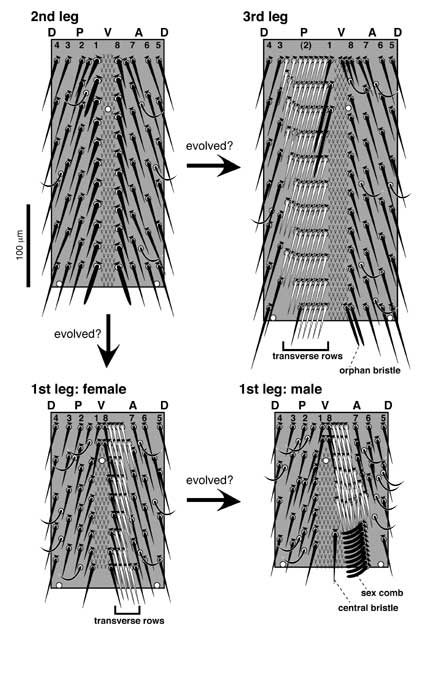Select image to enlarge

Figure 3.10
The four types of basitarsal bristle patterns in D. melanogaster.
Each segment is drawn as if slit along its dorsal (D) midline and spread flat (V, ventral; A, anterior; P, posterior), with its proximal edge at the top. Arrowheads (upper left) mark A/P lineage compartment boundaries [1800, 4076]. Only the 1st leg is sexually dimorphic.
The 2nd-leg pattern is simplest and maybe most primitive. Its basitarsus has 8 rows of mechanosensory bristles (numbered at top), each of which bears a bract (triangle) at its base. The 5 curved 'bractless' bristles reside between the rows and are chemosensory [3061]. Also shown are sensilla campaniformia (stretch-dectectors [4342, 4841, 4887], white circles) and trichoid hairs (small 'v's). Between rows 1 and 8 almost every cell makes a hair, so the hair density indicates cell size on the segment. There are ~2000 epidermal cells on the 2nd-leg basitarsus [1801].
The 1st- and 3rd-leg basitarsi augment this basic pattern with transverse rows of lighter-colored bristles. Similar rows decorate the tibias of those legs, but most of the tibial transverse-row bristles lack bracts [1714]. Transverse rows serve as brushes for cleaning the eyes (1st leg) or wings (3rd leg), and they are ideally located (A vs. P) for this role [4462]. Bristle lengths and intervals tend to increase from V-to-D in all patterns.
In males, the most distal transverse row rotates ~90° during development to form the 'sex comb' [4344], which may function during courtship [1692, 4039]. Males also differ from females in having extra bractless bristles between rows 5 and 6 [1714].
In the hypothetical scheme indicated by the arrows [1883, 4096] all three leg pairs originally resembled the 2nd-leg pattern. Transverse rows then evolved in 1st and 3rd legs of both sexes, and males acquired a sex comb. The central and orphan bristles may be vestiges of these changes (see text). Alternatively, evolution might have gone the other way -- i.e., simplifying an initially complex pattern. In PolycomblikeLOF mutants, the 2nd leg acquires two sets of transverse rows (not shown) [1122]: one set on its A side (plus a sex comb in males) where it becomes a 1st leg and another set on its P side where it becomes a 3rd leg (see [1713]). This 'homeotic schizophrenia' is a default state (cf. Table 8.1) where the Polycomb Group of 'memory genes' malfunctions -- thereby allowing certain homeotic genes to stay ON where they should be OFF [1508, 1509]. (Such defaults are not conclusive, however, since an opposite type of default is seen when these same homeotic genes are disabled [4149] -- i.e., 1st and 3rd legs look like 2nd legs.)
Drawings are for left legs from actual wild-type flies but are idealized insofar as (1) segments are not perfect cylinders, (2) hairs are not so neatly arranged, and (3) color shadings in vivo make it difficult to discern where transverse rows end and longitudinal rows begin, and (4) segment widths are exaggerated to avoid bristle overlaps (lengths are accurate). See also App. 7.
|
|
